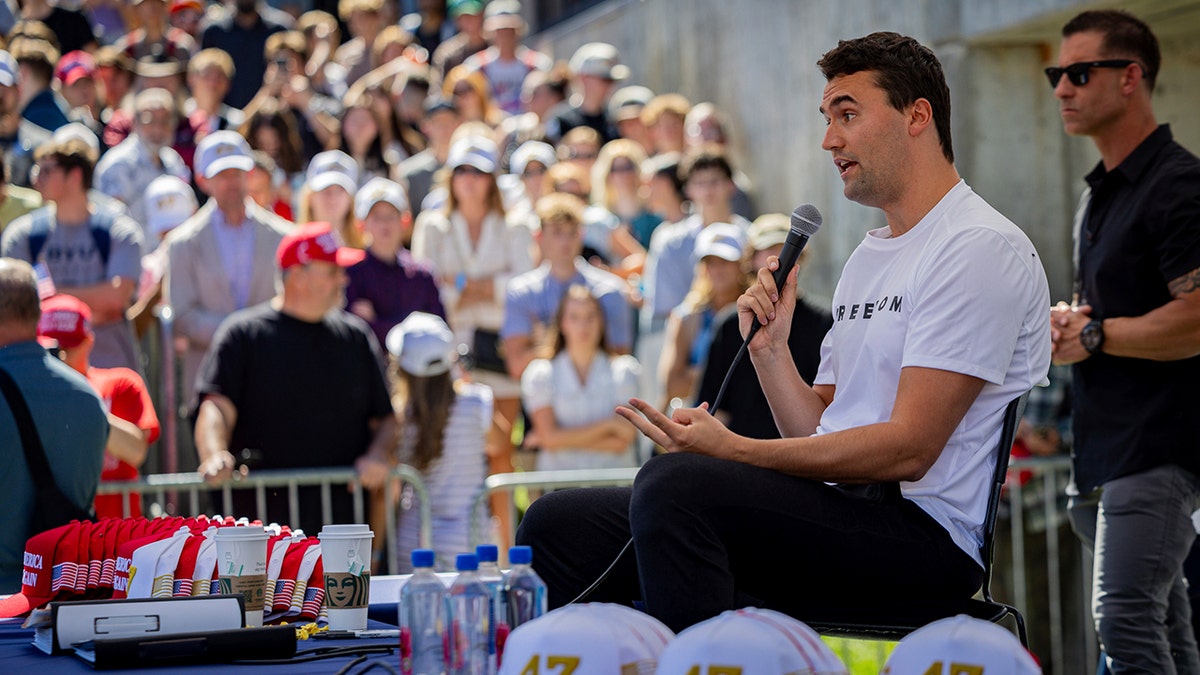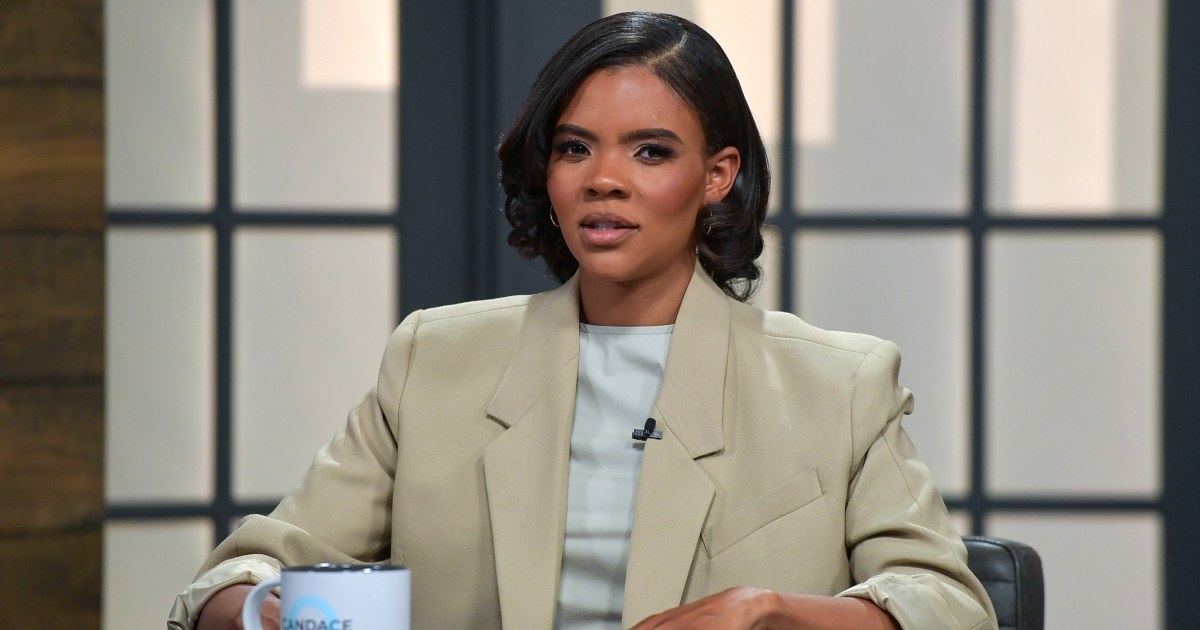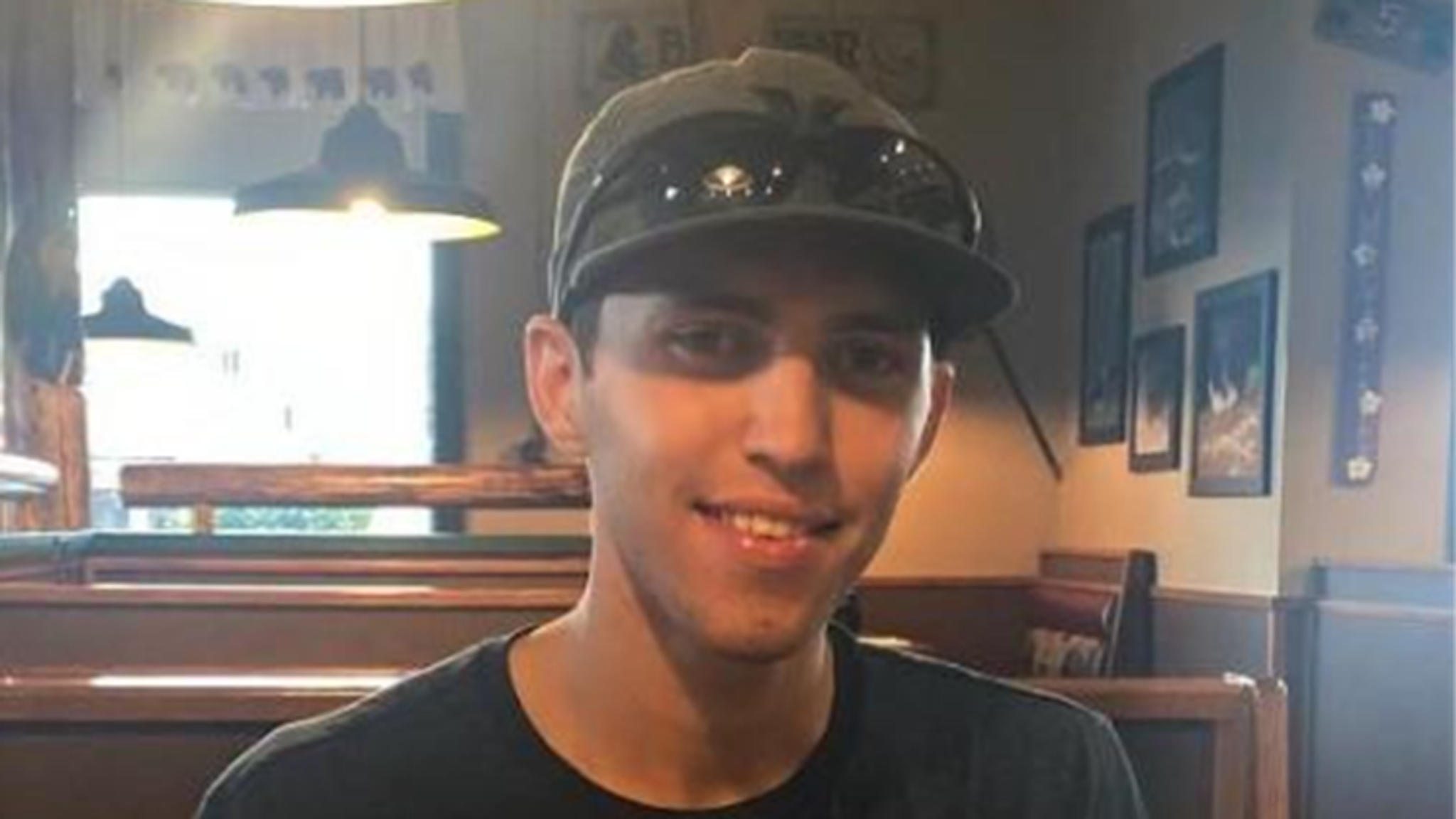Erika shared a beautiful photo with Charlie Kirk from their early morning hike — but what she revealed about their Saturdays left millions in tears.
“Saturdays Used to Belong to Us” — Erika’s Story of Love, Loss, and the Quiet Power of Memory
The first light of dawn was just beginning to break when Erika reached the top of the trail. The sky was still half-asleep, painted with faint streaks of rose and gold, and the air carried that early morning chill that only hikers know — sharp enough to make you shiver, but alive with promise.
She looked down at her phone and opened a photo that had been taken in this very spot — two smiling faces, side by side, framed by a sunrise that seemed to bless them both.
Charlie’s smile filled the screen. It was gentle, easy, and utterly unguarded — the kind of smile that came from someone who felt completely at peace with the world.
That morning, Erika shared that same photo online with a simple caption:
“Saturdays used to be the day he belonged to us.”
She didn’t expect what would happen next.
Within hours, thousands of people began to react. Comments poured in from strangers around the world — messages of love, empathy, and shared loss. Many said they cried reading her words, not just because of what she had lost, but because it reminded them of something — or someone — they had taken for granted.
Erika didn’t write those words to be poetic. She wrote them because they were true.
The Saturdays That Used to Be
For as long as she could remember, Saturdays had been
It didn’t matter if work was demanding or if the weather wasn’t perfect. Saturdays were sacred. Sometimes they would spend the day hiking; other times it would just be a quiet breakfast at home with pancakes and laughter echoing through the kitchen. Charlie had a way of turning the simplest routines into memories that lasted forever.
He wasn’t loud or showy about it. He didn’t make big speeches about love or time or family. He just showed up — every week, every time.
“Saturday’s ours,” he used to say with a wink, pouring coffee into Erika’s favorite mug. “You and the kids — that’s the deal.”
And it really was.
Those mornings were slow and gentle. The kids would run into the bedroom before the sun was fully up, jumping on the bed while Charlie groaned playfully, pretending to be annoyed. Erika would lie there, watching him wrestle with two giggling children, knowing deep down that this — this mess, this noise, this love — was everything she’d ever wanted.
The Photo That Started It All
The photo she shared — the one that went viral — wasn’t even taken on a special day.
It was just another Saturday.
They had decided to go for a hike near their home. The trail wasn’t particularly difficult, but it had a quiet beauty to it: tall pines, cool air, and a view of the valley below that made everything else fade away.
Charlie had insisted on leaving early, long before sunrise. “We’ll catch the first light,” he said, his eyes sparkling with that boyish enthusiasm Erika loved so much.
And so they did.
She remembered how he walked ahead of her on the narrow path, carrying the small backpack with their breakfast sandwiches. The sound of his boots crunching against the gravel mixed with birdsong — faint, distant, but full of life. When they reached the top, the world was still half-asleep. The first rays of sun kissed the horizon, and Charlie turned to her with that quiet smile.
“See?” he whispered. “Told you it’d be worth it.”
He wrapped his arm around her, and she held up her phone to take a quick picture — not realizing that this simple, spontaneous photo would one day become the one she’d hold onto more than anything else.
After He Was Gone
The weeks after Charlie’s passing blurred together like a long, gray winter.
People came and went. Flowers arrived. The phone rang constantly. Everyone wanted to offer comfort, but nothing anyone said could fill the silence that followed him.
It wasn’t just the big things she missed — not the vacations or celebrations — but the tiny details that stitched their life together: the way he brewed her coffee just right, the way his laughter filled the house, the sound of his keys jingling at the door every Friday night.
Saturday came, and for the first time in years, the house was still.
She woke up early out of habit, expecting to hear his footsteps or the kids running to jump on the bed. But there was nothing. Just quiet.
The emptiness hit her in waves.
Later that morning, she sat by the window, watching sunlight crawl across the living room floor. The kids were still asleep, their small breaths rising and falling peacefully — unaware that the rhythm of their world had changed. She held her phone, scrolling through old photos, and there he was again: Charlie, smiling, alive, real.
That’s when she wrote it.
“Saturdays used to be the day he belonged to us.”
It was simple. It wasn’t meant for anyone else. It was just her way of speaking to him — of keeping him close, even for a moment.
The World Responds
What happened next stunned her.
Within hours, her post had been shared thousands of times. People she’d never met were commenting things like:
“This broke me. I lost my dad last year. Saturdays were our day too.”
“I’m hugging my husband tighter after reading this.”
“Thank you for reminding me what really matters.”
The story spread quietly, without any media push or viral gimmick. It resonated because it was real.
And that’s the thing about loss — it connects us in ways words can’t explain. When Erika wrote that one sentence, she unknowingly gave voice to millions of silent hearts around the world who were missing someone, somewhere, right now.
The Little Things That Stay
Time has a strange way of softening pain.
Months passed. The seasons changed. The kids grew taller. Life, as it always does, kept moving.
But Erika found herself drawn to small rituals that helped her feel close to Charlie again. Every Saturday, she would take a morning walk — sometimes alone, sometimes with the kids — and she’d whisper a quiet “good morning” to the sky.
She’d make pancakes using his old recipe, even when the kids were too busy to eat with her. She’d play the same songs he used to hum while fixing the car.
Each tiny act became a thread in the invisible fabric that still connected them.
She realized something powerful: love doesn’t disappear when a person does. It just changes shape.
A Letter to the Saturdays Ahead
One evening, she began writing letters — not to anyone in particular, but to the Saturdays she once knew. She’d write about the past, about laughter, about coffee stains and messy picnics and the way Charlie used to chase the kids around the garden.
She didn’t post these letters anywhere. She kept them folded in a small wooden box, along with photos and ticket stubs and tiny memories that no one else would understand.
Sometimes, when the weight of missing him became too much, she’d take one out and read it under the soft glow of the bedside lamp.
It wasn’t sadness she felt anymore — not exactly. It was love, still alive, still beating, just in a quieter form.
The Hike Revisited
Almost a year after Charlie’s passing, Erika decided to return to that same trail — the one where they took the photo.
It was early — the world still wrapped in darkness — when she started climbing. Every step brought back memories: his laughter, his voice, his warmth.
When she reached the top, the sun was just beginning to rise. She stood there for a long time, breathing in the cold air, and whispered, “We made it, Charlie.”
Then she took another photo — this time, of the sunrise alone. She didn’t post it online. She kept it for herself, quietly knowing that somewhere, somehow, he was still part of it.
The Quiet Lesson
Erika often says she doesn’t want her story to be one of tragedy. She wants it to be about remembrance. About love that endures.
Her simple post — that one line — wasn’t about death. It was about presence. About how, even when someone is gone, the echo of their love keeps shaping the days that follow.
She’s received thousands of messages since then — from widows, parents, children, even strangers who just wanted to say thank you. And each one reminds her of the same truth Charlie lived by:
That the most valuable gift we ever give anyone is our time.
Not money. Not things. Just time.
Time to listen, to laugh, to be there.
What Saturdays Mean Now
Saturdays are still hard sometimes. There are moments when the silence feels too heavy, when the memories come rushing back too fast. But there are also moments of peace.
Now, every Saturday morning, Erika sits by the window with her coffee. The kids sleep in longer these days, but she doesn’t mind. She watches the sunrise and lets the light spill into the room.
Sometimes she imagines Charlie sitting across from her, still smiling that quiet smile — the one that made her feel like everything was okay.
And in a way, it still is.
Because even though he’s gone, his love still fills their home. It lives in the laughter of their children, in the warmth of the sunlight on her face, in the way the weekends still belong to them — just differently now.
The Message That Stayed
When people ask why her post touched so many hearts, Erika always says it’s not about her story — it’s about what it reminded people of.
Everyone has a “Saturday.”
A moment.
A person.
A tradition that once felt ordinary, until it was gone.
And maybe that’s what made her words so powerful. Because they weren’t about loss, but about gratefulness. About cherishing what we have while we have it.
Closing Reflection
It’s been over two years now since that morning hike. The world has changed in countless ways, but that single photo — that one frozen smile — continues to carry meaning far beyond what Erika ever imagined.
Every so often, she still receives a message from someone new. A young mother. An elderly man. A friend who’s just lost someone.
They all say the same thing:
“Your story helped me remember what really matters.”
And maybe that’s the quiet miracle of it all — that one small act of love, one honest sentence, can ripple through the world and remind millions to hold their loved ones a little closer, to live their ordinary Saturdays as if they were the most precious thing on earth.
Because in the end, they are.
And though Charlie is gone, the promise he made — to make Saturdays theirs — will never fade.
Now, every sunrise feels like his smile returning for a brief hello, every weekend a gentle reminder that love, once given, never truly disappears.
It only changes form.
It becomes light.
And light, once seen, never really leaves us.
The Seasons After
Time, as Erika learned, doesn’t heal all wounds — it teaches you how to live with them.
When autumn came, the world outside her window turned gold. Leaves drifted down like slow-motion memories, whispering their own kind of goodbye. Erika found herself walking through the park one morning, the same park where she and Charlie used to take the kids for ice cream after long hikes. She sat on the same bench they once shared, running her fingers along the old wooden surface, now cracked and weathered by rain and sun.
It struck her how much the world kept moving, even when she didn’t feel ready to. People laughed, dogs barked, children ran past — life went on, quietly, gently, persistently.
She smiled through the ache. Maybe that’s how healing really works — not as a sudden miracle, but as a gradual acceptance that it’s okay for the world to keep turning.
Every season after Charlie’s passing carried its own lesson.

Winter taught her stillness — the courage to sit with silence.
Spring reminded her that growth can happen even in pain.
Summer brought laughter back into the house, timid at first, then stronger.
And autumn… autumn reminded her of him most of all.
He had always loved the fall — the colors, the crisp air, the long shadows stretching across the fields. She could almost hear him saying, “Look at that light, Erika. It’s perfect.”
SPECIAL VIDEO: ‘EVERYTHING WE THOUGHT WAS WRONG…’ Viral Clip Shows Charlie Kirk Collapsing From Behind — Not by Tyler Robinson — Candace Owens Drops New Evidence That Leaves Millions Staring at Their Screens, Questioning What They Thought They Knew.ABC

The Clip That Shook the Nation
It started with a single notification. A grainy thumbnail on YouTube. A headline that looked too outrageous to believe. And yet, within hours, millions had clicked, watched, replayed, and gasped.
The video—now simply referred to as “The Collapse Clip”—shows what appears to be Charlie Kirk in his final moments. But the angle is different. The perspective is raw. And what it reveals has detonated like a bomb across America: Kirk doesn’t fall forward, as the prosecution’s narrative once suggested. He stumbles
backward.Backward—away from an unseen force. Away from something no one expected.
The implication is terrifying. For months, the world was told that 22-year-old Tyler Robinson pulled the trigger. That he was the lone man responsible for the assassination that rocked a movement. That his fingerprints, his presence, his motive, were all the proof anyone needed. But now, with a shaky camera and a few seconds of footage, the foundation of that “airtight case” is starting to look like quicksand.

The Official Story — and Its Cracks
The narrative was straightforward—or so it seemed. Tyler Robinson, a disillusioned young man from a fractured family, allegedly brought a firearm to campus. Charlie Kirk, the conservative firebrand, was addressing a packed auditorium when the shots rang out. Witnesses claimed they saw Tyler in the vicinity. Security footage showed him on campus earlier in the day. The police announced their suspect within hours.
And just like that, the story hardened into stone. The media carried it as fact. Commentators framed it as the act of a troubled loner, lashing out at a figure he despised. Court filings painted Tyler as guilty before his trial even began.
But cracks had been forming from the very beginning. His alibi didn’t completely align with the timeline. Some eyewitnesses contradicted each other. Ballistics experts hinted at inconsistencies but were drowned out by louder voices demanding swift justice.
The case became less about evidence and more about narrative. A villain had been chosen, and the script had been written.
Until the video surfaced.

The Clip Nobody Expected
The footage is brief—just 23 seconds—but it has upended months of certainty. Shot on a smartphone from the back corner of the auditorium, the video shows Kirk mid-sentence, gesturing to the crowd. The moment is eerily ordinary… until it isn’t.
In the frame, there’s no visible shooter. No sudden flash from the direction where Tyler Robinson was said to be. Instead, Kirk jolts as if struck from behind. His body stiffens, his words cut off, and then he collapses backwards into chaos.
Gasps fill the video. People scream. The camera shakes wildly as the amateur filmer ducks, then lifts the lens again. The pandemonium is undeniable, but so is the shocking trajectory of Kirk’s fall.
This wasn’t how the prosecution described it. This wasn’t how the case was sold to the public. And as the clip circulates, viewers can’t stop asking: If Kirk fell backward, then where was the real shooter?

Candace Owens Enters the Storm
As if the footage wasn’t enough, Candace Owens poured gasoline on the fire. Within hours of the clip going viral, she went live on X (formerly Twitter), holding up what she claimed was “new, undeniable evidence.”
Her words were sharp, her tone fierce. “This isn’t speculation. This is proof the story we were fed was a lie.”
She released what she called “supporting documents”—fragments of security logs, blurred still frames, and redacted testimonies that appeared to suggest alternative suspects had been considered early in the investigation, then mysteriously dropped.
“Tyler Robinson was a scapegoat,” Owens declared. “The footage proves it, and the documents confirm it.”
The timing was perfect—or disastrous, depending on who you ask. Within minutes, hashtags exploded across platforms:
Millions weren’t just watching; they were demanding answers.

The Public Reacts
The nation divided instantly. Some viewers argued the video was misleading, that angles and lighting can distort perception. Others insisted the clip was the missing puzzle piece, the “smoking gun” that exposed a cover-up.
Social media filled with slowed-down replays, frame-by-frame analysis, and wild speculation. Amateur sleuths mapped the auditorium, measured distances, and overlaid diagrams. Conspiracy theories bloomed overnight: Was there a second shooter? Did authorities suppress this footage deliberately? Was Charlie Kirk caught in a larger plot?
Even mainstream outlets, initially dismissive, were forced to cover the uproar. CNN called it “a viral sensation with potentially serious implications.” Fox News labeled it “a devastating challenge to the official narrative.” Independent podcasters called it “the JFK moment of our generation.”
And yet, amid the frenzy, one truth became impossible to ignore: the story the public thought they knew was unraveling.

A Divided Court of Public Opinion
The morning after the video first broke, television newsrooms across the country scrambled to respond. “This is either the most important piece of footage in the case—or the most dangerous piece of misinformation,” one CNN anchor cautioned. On Fox, meanwhile, a commentator called it “the unraveling of the biggest political frame-up in recent memory.”
The divide wasn’t just political—it was generational. Younger viewers flooded TikTok with analysis clips, arguing that the case against Tyler Robinson never added up. Older, more traditional audiences were wary: why hadn’t investigators released this earlier? Was the clip even authentic?
Fact-checkers rushed in, but instead of calming the chaos, their verdicts made it worse. Some declared the footage genuine but “inconclusive.” Others labeled it “potentially doctored.” Nobody could agree. And in that vacuum of certainty, conspiracy theories multiplied.
Ballistics Don’t Lie… Or Do They?
Forensic experts quickly became the most sought-after voices. CNN booked Dr. Helen Rourke, a ballistics analyst with thirty years of courtroom experience. Her words stunned viewers:
“If this footage is authentic, then the angle of Charlie Kirk’s fall is inconsistent with the prosecution’s claim that Tyler Robinson was directly in front of him. Physics doesn’t take sides. A backward collapse usually indicates impact from behind.”
That one sentence ricocheted across the internet.
But others pushed back. Former FBI investigator Daniel Kramer argued that adrenaline, shock, or even stumbling over equipment on stage could explain the backward fall. “You can’t conclude guilt or innocence from one shaky video,” he said.
Still, the public wasn’t satisfied. To them, every expert was either “part of the cover-up” or “finally telling the truth.”
Enter the Whistleblower
Then came the leak.
Two days after Candace Owens dropped her documents, an anonymous account on X posted a thread claiming to be from “inside the investigation.” The whistleblower alleged that authorities had
always known there were conflicting angles of the shooting but chose to withhold them “to preserve the integrity of the case.”The thread included what looked like internal memos, stamped with official seals, describing “multiple potential shooter trajectories.” One memo even referenced “a rear-entry wound,” though heavily redacted.
Authenticity couldn’t be confirmed, but the timing was lethal. Screenshots of the thread spread like wildfire. Millions began to wonder: had the public been deliberately deceived?

The Mystery of the Missing Seconds
Perhaps the most haunting detail wasn’t what the video showed—but what it didn’t.
The viral clip cuts off just as Kirk hits the ground. Viewers are left with the chaos of screams and blurred movement. The shooter, if visible, is never caught on frame. Those final seconds—the moments when clarity might emerge—are missing.
Why?
The filmer, later identified as a college sophomore named Lauren Hale, claimed she dropped her phone in panic. “I thought I was about to die,” she told reporters. “I wasn’t trying to film evidence. I was just trying to survive.”
Skeptics weren’t convinced. Some suggested her phone was confiscated and tampered with. Others whispered that Hale herself had been pressured into silence.
When pressed, Lauren broke down in tears on camera. “All I know is what I saw,” she said. “And it didn’t look like it came from the front.”
Candace Owens Doubles Down
Owens wasn’t about to let the momentum slip. On her podcast, she declared that the video was “the smoking gun they tried to bury.”
“Tyler Robinson is innocent,” she thundered. “And Charlie Kirk didn’t just die—he was silenced.”
Her words were carefully chosen, dripping with implication. Owens claimed she had more evidence to release “at the right time.” That promise alone was enough to keep her name trending for days.
But critics blasted her for exploiting tragedy. MSNBC accused her of “turning a nation’s grief into a personal brand expansion.” Columnists wrote that Owens was “playing with fire” and fueling instability.
None of it mattered. Her audience ballooned. Every word she spoke was dissected, debated, and devoured.
A Case in Collapse?
Inside the courthouse, prosecutors faced mounting pressure. Tyler Robinson’s defense team filed a motion demanding the video be entered as new evidence. Judges hesitated. Investigators stayed silent.
But the silence only screamed louder.
“Why won’t they address it?” one viral TikTok asked. “If it’s fake, say so. If it’s real, explain it. The fact they’re hiding proves everything.”
Soon, chants of “Free Tyler!” began echoing outside the courthouse. Protesters carried signs:
Release the Full Footage!
Who’s the Real Shooter?
Justice for Kirk, Justice for Truth
The case that once seemed sealed was now teetering on the brink.







